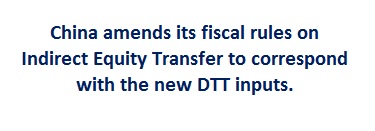Chinese Taxation Recent Updates - PART II
Updates on Taxation on Indirect Equity Transfer: Circular 7
By Diego D'Alma (Principal Associate), Guanyu Shen (Associate) and Manuel Torres (Partner and Shanghai & Beijing Office Director).
 Prior to the issuance of Circular 7, when a foreign transferor transfers their equity participation in an intermediary holding company - and the intermediary holding company owned an equity participation in a Chinese transferee ("Indirect Equity Transfer", under Circular 698) - the Chinese tax authority may review the status of the intermediary company. If the said intermediary company is recognized as lacking business substance by the Chinese tax authority, such Indirect Equity Transfer would be deemed as a direct transfer of Chinese taxable assets and, thus, any capital gains derived there from shall be subject to Chinese EIT, which should be withheld by a Chinese buyer or be self-declared by the transferor if the buyer is also a foreign entity. Further to the above, such equity transfer may trigger a reporting obligation to the Chinese tax bureau when either of the following conditions are met:
Prior to the issuance of Circular 7, when a foreign transferor transfers their equity participation in an intermediary holding company - and the intermediary holding company owned an equity participation in a Chinese transferee ("Indirect Equity Transfer", under Circular 698) - the Chinese tax authority may review the status of the intermediary company. If the said intermediary company is recognized as lacking business substance by the Chinese tax authority, such Indirect Equity Transfer would be deemed as a direct transfer of Chinese taxable assets and, thus, any capital gains derived there from shall be subject to Chinese EIT, which should be withheld by a Chinese buyer or be self-declared by the transferor if the buyer is also a foreign entity. Further to the above, such equity transfer may trigger a reporting obligation to the Chinese tax bureau when either of the following conditions are met:
- The holding jurisdiction has an effective EIT rate lower than 12.5 percent, or
- The holding jurisdiction does not levy tax on foreign-sourced income for residents
With the issuance of Circular 7, the parties in the Indirect Equity Transfer may or may not choose to report based on their own discretion towards the Indirect Equity Transfer. However, there might be serious tax results for non-reporting as follows in case that the intermediary company is looked through and such Indirect Equity Transfer may be subject to Chinese EIT accordingly:
- The Chinese buyer, if deemed to have withheld any tax obligations, shall be subject to a punishment by the Chinese tax bureau; however, if the buyer reported the deal to the Chinese tax bureau within 30 days of the conclusion of the equity transfer agreement, its liability can be exempted or reduced;
- Interest rates can be charged at a standard lending rate issued by Chinese banks in the same period; however, if the Indirect Equity Transfer was not reported by the foreign transferor, it would be imposed by an interest rate of the aforementioned plus five percent.
Circular 7 introduces pitfalls for the direct recognition of non-business purposes if the following conditions are met:
- 75 percent or more value of the equity being transferred counting on China taxable assets
- 90 percent or more total assets or revenue of the foreign enterprise counting on China taxable assets
- the intermediary holding company has limited function and bears limited risk
- overseas tax paid is lower than potential China tax in case of direct equity transfer
Besides, Circular 7 also introduces safe harbors for direct recognition of business purposes for any of the following cases:
- The intermediary holding company is listed
- The Indirect Equity Transfer is non-taxable in China by virtue of certain DTTs
- If the following are met together:
- the equity transferor and transferee share an 80 percent (100 percent if China taxable assets are property-rich) holding affiliated within the same group
- the equity transfer does not result in less tax being contributed in China
- 100 percent consideration is paid via share consideration by the transferee

Garrigues' comments:
MNCs are recommended to observe the purposes of their transactions, especially paying attention to the pitfalls and safe harbors in recognition of having or lacking business purposes, and duly report obligations to the in-charge Chinese tax bureau where necessary.
Additionally, the issuance of Circular 7 may also be understood as a response/update for the global tax hot-topic of Base Erosion and Profits Shifting (BEPS), taking into consideration the new DTTs recently entered into by China.
It was questionable previously whether the original mandatory reporting liability under Circular 698 by foreign investors for Indirect Equity Transfer is compliant with relevant DTTs. Taking the Sino-Spain DTT for example, Article 13.6 regulates a general principle that the capital gains of Spanish investors, derived from equity transfers, shall be taxed only in Spain, unless the Spanish investor holds an equity in a Chinese subsidiary amounting to 25 percent participation (Article 13.5), where China would have a taxing right. Article 13.5 does not mention that the 25 percent participation shall be direct or indirect participation, which generates an argument that Indirect Equity Transfer by a Spanish investor shall be taxed only in Spain, according to Article 13.6, and Circular 698's reporting liability might be overruled by the Sino-Spain DTT.
However, new DTTs entered into by China recently adopted the new OECD model in this connection, where the DTTs specifically grant rights to China for taxation in the case of Indirect Equity Transfer. Taking the new Sino-France DTT as an example, its Article 13.5 stipulates that "gains derived by a resident of a contracting state from the alienation of shares - other than those mentioned in Paragraph 4 - of a resident company of the other contracting state may be taxable in that other contracting state if the recipient of the gain, at any time during the 12-month period preceding such alienation, had a participation, directly or indirectly, in at least 25 percent of the shares of that company". It could be understandable that China amends its fiscal rules on Indirect Equity Transfer to correspond with the new DTT inputs.
 1.Updates on Encouraging M&A: Circular 109
1.Updates on Encouraging M&A: Circular 109
Under Chinese EIT Law (2008), companies undergoing corporate restructuring have to recognize gains/losses from the transfer of relevant assets or equity at fair market value when the transactions take place. When the following conditions - as per Circular 59 - are met, companies may choose to opt for Special Tax Treatment (STT) which is effectively a tax deferral upon completion of the necessary filing procedures.
- The corporate restructuring has reasonable commercial purposes without tax delay or avoidance purposes
- The equity or assets being acquired must reach a stipulated ratio over the total equity or assets (75%)
- There is no change in the original operating activities within a prescribed period of time after restructuring
- Share consideration has to comprise at least 85 percent out of the total consideration
- The equity consideration received shall not be transferred within a prescribed period of time
New Circular 109 introduces improvements on EIT special treatment with respect to corporate restructuring. Firstly, the minimum ratio of equity or assets being acquired has been rendered from 75 to 50 percent. Besides, Circular 109 sets out a new type of STT for domestic intra-group equity and assets assignments between resident companies, which is applicable when the following conditions are met:
- The transferor and the transferee have a 100 percent direct investment holding relationship; or the transferor and the transferee are 100 percent owned by the same resident company or the same resident companies
- The transaction is conducted for reasonable commercial purposes
- There is no change in the original operating activities within 12 months of the transaction
In the abovementioned case, no capital gains shall be recognized in the restructuring (non-taxability consequences, rather than tax deferrals).
Garrigues comments:
The lifting of EIT restructuring rules under Circular 109 will relieve the burden of corporate M&A and intra-group restructuring activities within China. MNCs are recommended to optimize transaction patterns, so as to leverage this significant improvement on EIT special treatment for corporate restructuring transactions. Besides, since Chinese tax bureaus are paying attention on "reasonable commercial purpose" of restructuring transactions, it is recommended to support the restructuring transactions with sufficient commercial justifications in order to achieve tax efficiency.
 2.Tax Preferential Treatments on Western Area of China: Circular 14
2.Tax Preferential Treatments on Western Area of China: Circular 14
For companies incorporated in the west area of China, they can enjoy preferential EIT treatment - i.e. a reduced EIT rate of 15 percent, when the following conditions could be met:
- The primary business of the company is listed in the newly-added encouraged industry items provided in the Catalogue of Encouraged Industries in Western Regions
- The annual primary business revenue of the company accounts for more than 70 percent of the total company revenue
The payment of EIT at the reduced tax rate of 15 percent shall cease to apply to companies that have enjoyed preferential EIT treatment if their primary business is no longer listed in the encouraged industry items provided in the Catalogue of Encouraged Industries in Western Regions.
Garrigues' comments:
When deciding to incorporate or relocate to western areas of China, MNCs should look at it holistically and not be swayed by the low EIR rate - e.g. standards of infrastructure and living should also be addressed before any decisions are made.
--END--